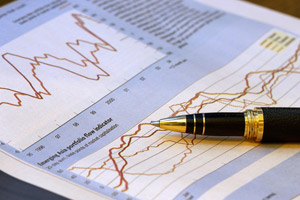Technical Analysis or How to Forecast Future Financial Price Movements
Technical analysis enables traders to evaluate securities based on indicators such as volume and past prices. The goal is to predict future activity and future price fluctuations.
The Basis of Technical Analysis
Technical analysts use different tools, including charts and indicators such as volume, distribution line, Aroon indicator, average directional index, and others. One of the main principles is that history repeats itself. Analysis is also based on the principle that market action is the most important factor. Price movement is the third factor. Analysts assume that prices tend to move in trends. They may move sideways, up, and down. Based on these assumptions, technical analysis can be applied to different instruments, including futures, commodities, indices, stocks, and others. It is applied to monthly, weekly, daily, and even intraday data. In general, analysts study price action and use historical volume and price data and apply it to forex trading, fixed-income securities, and other instruments.
Analysts also use several tools to identify different entry points – real-time news, ECN and level II quotes, and intraday candlestick charts. There are different trading styles, and analysts take them into account to determine a price target. Investors use trading strategies such as momentum, daily picots, fading, scalping, and others. Daily pivots is one strategy whereby investors focus on stock volatility. Scalping is another strategy and a popular investment tool. Traders focus on profitability and sell stock once it becomes evident that the trade is profitable. Fading is a strategy of shorting stocks. With momentum, traders focus on news releases to identify predictable and strong trends.

Are Prices Movements Totally Random
While price movements are not totally random, analysts agree that there are longer periods of random behavior. Non-random behavior occurs less often. The goal is to identify trends and patterns within shorter and extended periods. Analysts study and identify downward and upward trends and how they unfold in time. They use charts to assess movements in asset prices. There are two basic types of charts – short-term and long-term charts.
Steps to Technical Evaluation
Technical analysis involves several steps to identify trends. The first step is to choose technical indicators that will help you to make a sound trading decision. Such indicators are Stochastic, MACD, exponential moving average, moving average, and others. The next step is to use historical data to back test them. Set a stop loss point that works best. Once you identify stable predictable trends, you can start trading stock.
It is important to identify a predictable trend and measure the momentum. If you have volume data, then it is possible to assess the selling and buying pressure for indices and stocks. Determine the relative strength as well by using a benchmark. You can use indices such as S&P 500 for stock prices. The final step is to look at indicators such as possible entry levels, reward to risk ratio, and stage, maturity, and strength of trends.
Technical analysts also use software with different features, including custom indicators, alerts, back testing, charting, and others. Software also comes with broker interface, data feed, scanner, and optimization tools. Alerts, for example, are used to monitor different investment instruments, including warrants, currencies, options, stocks, and other equities. Analysts use open source and commercial platforms.
What Is Support/Resistance
Resistance refers to the price an instrument rarely moves above and then the price tends to bounce. If the price goes above certain level, it usually goes up until it reaches the next resistance level. Prices usually find a support level when moving down. If the price goes below the support level, it is likely to go down until it reaches the next support level.
Don't Be Biased
Given that data is subject to interpretation, analysts must be aware of personal biases. The analysis may have a bullish or bearish tilt if bias takes over. Then it is difficult to identify trends because analysts will spot patterns that fit into their personal bias. Different technical analysts may identify different patterns using the same tools and analyzing the same chart.
Summary
Technical analysis is a very broad topic, and different approaches are used to identify trends and analyze securities. While experts use a number of tools, analysis boils down to studying supply and demand to spot predictable trends. They look at indicators to predict future activity and use oscillators, indicators, and chart patterns to this. A combination of different tools can be used as well. Analysts study horizontal trends, downtrends, and uptrends as well as trend lengths (short-term, intermediate, and long-term). In any case, day trading is not the best choice for novice investors because the different techniques, tools, and strategies take time to master.
Related Articles
What Is Short Selling and How Does It Work
Short selling is the practice of selling a borrowed security to buy it back when the price declines. It is not the best strategy for novice investors because of the huge risk of loss. How Short Selling WorksThis is a short-term strategy because of factors such as inflation. Traders buy securities...
Gold as a Crisis Commodity and Investment Instrument
Investing in gold offers many benefits, and one is that this is an asset that protects savings from risks such as currency devaluation. In contrast to paper assets, there is no counterparty risk when investing in silver or gold. Investors who opt for precious metals are protected against monetary...
Portfolio Management for Different Investment Instruments
Portfolio management refers to asset allocation and management of bonds, stocks, shares and other securities. The term portfolio is used for a pool of investment instruments, including cash, mutual funds, bonds, and others. The aim of portfolio management is to maximize returns and minimize risks...
